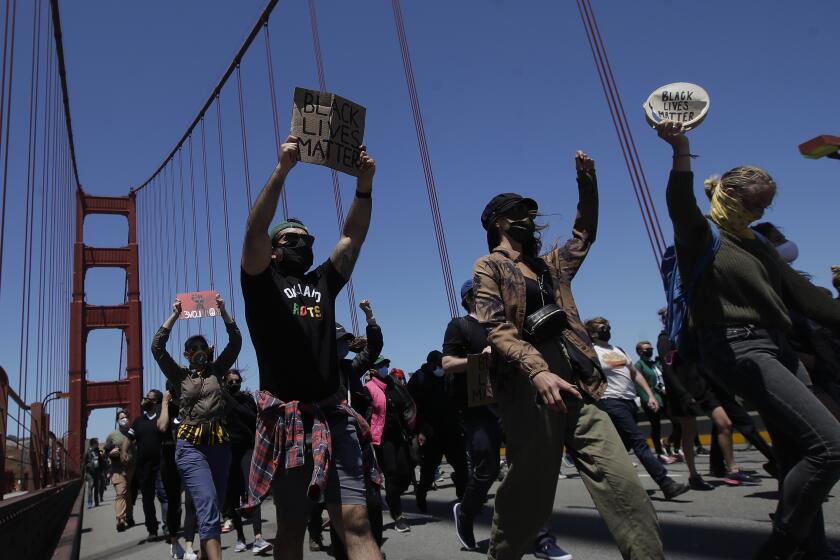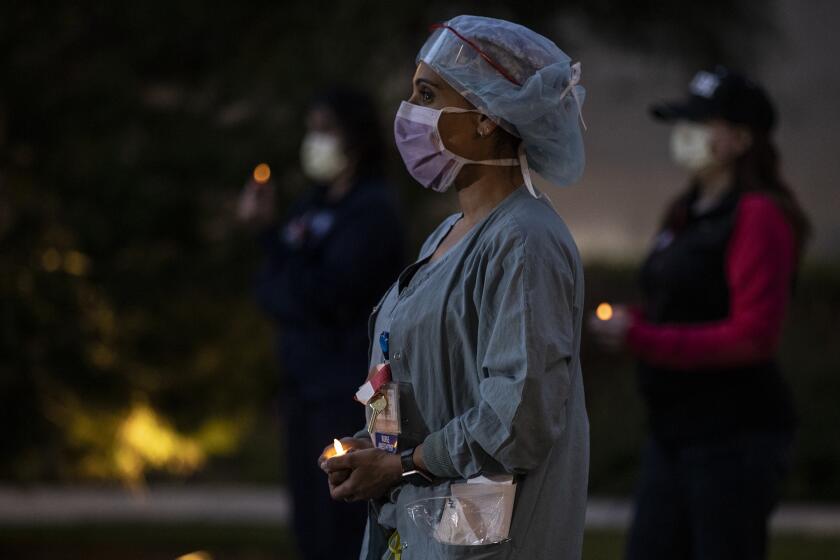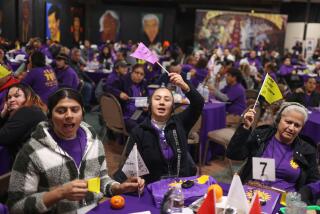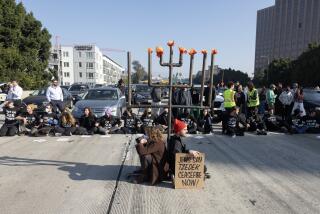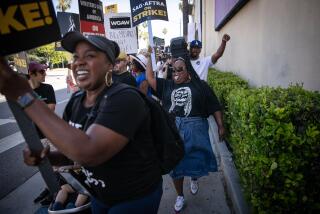Union-led protests express solidarity with Black Lives Matter
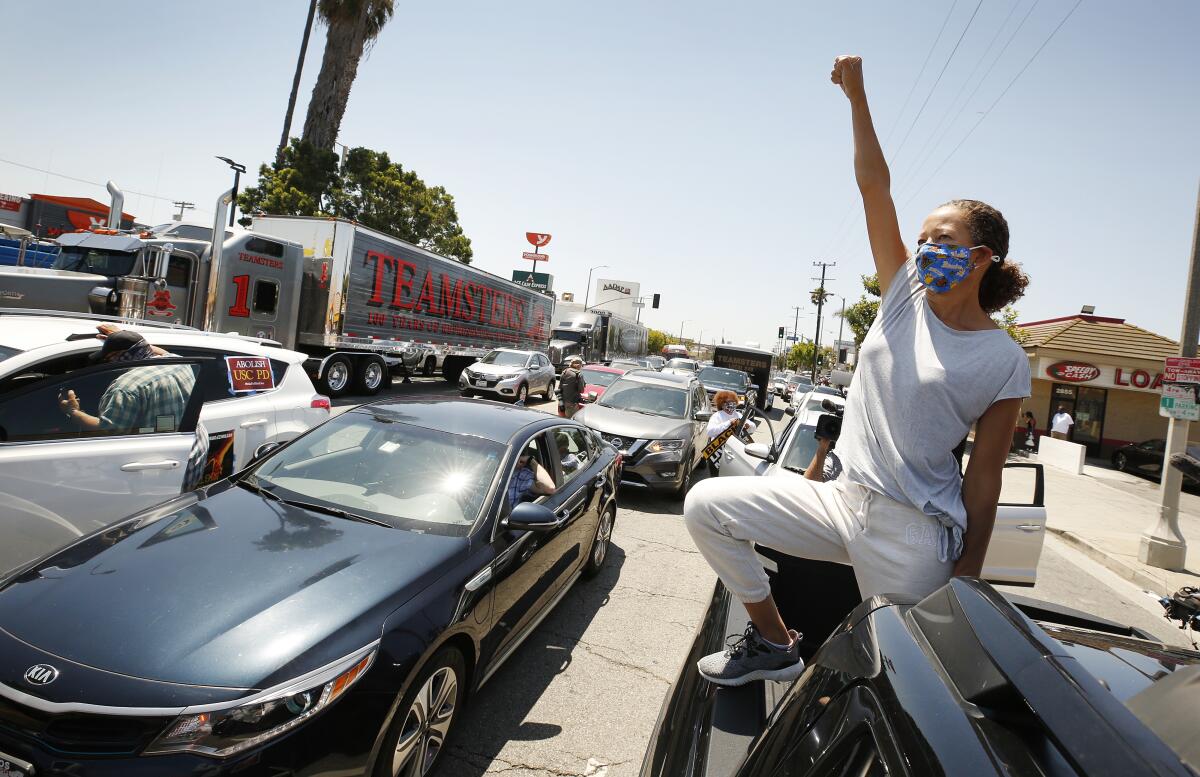
- Share via
Janitors, fast-food workers, nursing home employees and gig-economy drivers, many of them Black and Latino, rallied across the nation Monday in union-organized protests to express solidarity with the Black Lives Matter movement that has emerged as a powerful global force for racial justice.
In Los Angeles, San Francisco, Oakland and several other California cities, demonstrations were organized by the Service Employees International Union, one of the nation’s largest, whose 1.9 million members include many of the low-wage essential employees who have continued to work during the COVID-19 pandemic.
The protest, dubbed Strike for Black Lives, was aimed at highlighting the labor movement’s commitment to racial justice in the wake of a powerful reckoning on police brutality and systemic racism set off by the death of George Floyd, a Black man who died in Minneapolis police custody in late May.
A caravan of several hundred cars and trucks drove through South Los Angeles with “Strike for Black Lives” signs in English and Spanish on their windows. One large banner read, “Abolish USC police.” According to organizers, the Los Angeles protesters converged at a McDonald’s on Crenshaw Boulevard, where they blocked the driveway for eight minutes and 46 seconds — the amount of time a white police officer was initially reported to have held his knee on Floyd’s neck before he died.
In San Francisco, several hundred protesters marched on City Hall, banging drums and hoisting banners proclaiming, “Justice for Janitors,” “Share the prosperity” and “Essential workers for Black Lives Matter.” Several signs read, “SEIU: You shouldn’t have to die to feed your family.”
While the Black Lives Matter movement was first launched as an uprising against police violence, unions and progressive organizations that have spent years organizing low-wage workers seek to widen its focus to economic justice. The SEIU has been in the forefront of those efforts, spending millions of dollars in recent years in its “Fight For 15” campaign to raise minimum wages across the country.
Tech companies are famous for moving fast. Yet despite calling diversity a priority since 2014, they remain mostly white and mostly male.
“Since the killing of George Floyd, the massive upsurge in racial justice movements has been focused around police killings, but also more broadly on systemic racism,” said Kent Wong, director of the UCLA Labor Center, which has helped organize Los Angeles immigrant workers for decades. “The low-wage workers who have been organizing for better conditions also represent large concentrations of workers of color.”
The COVID-19 pandemic has also spurred low-wage workers, whether unionized or not, to mount protests advocating for safety measures in the workplace, paid sick leave, hazard pay and increased testing for infection.
“What the protesters are saying, that if we want to be concerned — and we should be — about police violence and people getting killed by the police ... we have to also be concerned about the people who are dying and being put into lethal situations through economic exploitation,” the Rev. William Barber II, co-chair of the Poor People’s Campaign, one of the organizations supporting Monday’s demonstrations, told the Associated Press.
The COVID-19 pandemic is unleashing a wave of labor unrest harnessing front-line workers’ fear and anger across California and the nation.
Monday’s protests addressed many of these demands but skirted some of the thorny issues involving race in the labor movement. The role of police unions in protecting rogue law enforcement officers went unmentioned. Also not in the spotlight were apprentice systems that tend to favor white workers, especially in unions representing firefighters, dockworkers and construction workers.
But although racial prejudice persists in the union movement as it does in corporate America, Wong said, Monday’s protests show “the beginning of a much more comprehensive movement-building strategy that aligns worker justice and racial justice. Many of the demonstrations are being led by a new generation of young activists.”
The convergence of racial justice and workers’ rights is coming at a time when the higher echelons of the labor movement, which have been dominated by white men, are diversifying. The National Education Assn., with 3 million members, is headed by a Latina, Lily Eskelsen García. Lee Saunders is the first Black president of the American Federation of State, County and Municipal Employees, with 1.4 million members.
Monday’s protests were endorsed by several other unions, including the Communications Workers of America, the United Farm Workers, the International Brotherhood of Teamsters and the Amalgamated Transit Union.
“A global health pandemic, an economic depression, and continued structural and systemic racism have converged in a perfect storm, and the lives of working class people of color have never been more at risk,” Transit Union President John Costa said in a statement supporting the Monday protests. “Now is not the time to be observers on the sidelines. Now is the time to rise up together to inaugurate a new day of racial and economic justice for all.”
Although ride-hailing drivers were prominently featured in the Strike for Black Lives news releases, not all major ride-hailing groups were part of the protest. Participants were mainly members of groups allied with the SEIU, including the Mobile Workers Alliance, funded by Los Angeles’ SEIU Local 721.
Rideshare Drivers United California, an 18,000-member group that in the past has taken a more militant stand than the SEIU against cooperating with Uber and Lyft, was not invited to the protests, according to one of its leaders, Nicole Moore.
“It was disappointing,” she said. “Because we are all united as drivers on how Uber and Lyft are skirting employment rights and hurting Black and brown communities. We strongly stand with folks fighting for Black and indigenous people of color who are the majority of our ride-share drivers.”
The Associated Press was used in compiling this report.
More to Read
Inside the business of entertainment
The Wide Shot brings you news, analysis and insights on everything from streaming wars to production — and what it all means for the future.
You may occasionally receive promotional content from the Los Angeles Times.

